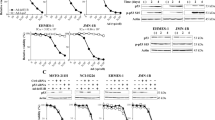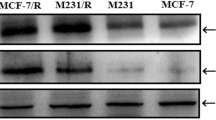Abstract
ING4 as a member of inhibitor of growth (ING) tumor suppressor family has potent inhibitory effects on a variety of tumors. Interleukin-24 (IL-24), a cytokine-tumor suppressor, also shows broad-spectrum and tumor-specific antitumor activities. In this report, we constructed an ING4/IL-24 bicistronic adenovirus (Ad-ING4-IL-24) and assessed its combined effect on in vitro and in vivo A549 human non-small cell lung cancer cells. We demonstrated that ING4 and IL-24 combination treatment by adenovirus-mediated ING4 and IL-24 coexpression induced additive growth suppression and apoptosis as well as an overlapping effect on upregulation of P21, P27, Fas, Bax and cleaved Caspases-8, 9, 3 and downregulation of Bcl-2 in in vitro A549 lung carcinoma cells. Moreover, Ad-ING4-IL-24 treatment additively inhibited in vivo A549 lung carcinoma subcutaneous (s.c.) xenografted tumor growth and reduced CD34 and microvessel density in A549 xenografted tumors in athymic nude mice. The enhanced antitumor activity elicited by Ad-ING4-IL-24 was closely associated with the coordinate activation of extrinsic and intrinsic apoptotic pathways and additive inhibition of tumor angiogenesis. Thus, our results indicate that cancer gene therapy combining two or more tumor suppressors such as ING4 and IL-24 may constitute a novel and effective therapeutic strategy for lung carcinoma and other cancers.
This is a preview of subscription content, access via your institution
Access options
Subscribe to this journal
Receive 12 print issues and online access
$259.00 per year
only $21.58 per issue
Buy this article
- Purchase on Springer Link
- Instant access to full article PDF
Prices may be subject to local taxes which are calculated during checkout





Similar content being viewed by others
References
Jemal A, Siegel R, Ward E, Murray T, Xu J, Thun MJ . Cancer statistics, 2007. CA Cancer J Clin 2007; 57: 43–66.
Wistuba II, Gazdar AF . Lung cancer preneoplasia. Annu Rev Pathol 2006; 1: 331–348.
Gridelli C, Langer C, Maione P, Rossi A, Schild SE . Lung cancer in the elderly. J Clin Oncol 2007; 25: 1898–1907.
Spiro SG, Silvestri GA . One hundred years of lung cancer. Am J Respir Crit Care Med 2005; 172: 523–529.
Garkavtsev I, Kozin SV, Chernova O, Xu L, Winkler F, Brown E et al. The candidate tumour suppressor protein ING4 regulates brain tumour growth and angiogenesis. Nature 2004; 428: 328–332.
Gunduz M, Nagatsuka H, Demircan K, Gunduz E, Cengiz B, Ouchida M et al. Frequent deletion and down-regulation of ING4, a candidate tumor suppressor gene at 12p13, in head and neck squamous cell carcinomas. Gene 2005; 356: 109–117.
Fang F, Luo LB, Tao YM, Wu F, Yang LY . Decreased expression of inhibitor of growth 4 correlated with poor prognosis of hepatocellular carcinoma. Cancer Epidemiol Biomarkers Prev 2009; 18: 409–416.
Li M, Jin Y, Sun WJ, Yu Y, Bai J, Tong DD et al. Reduced expression and novel splice variants of ING4 in human gastric adenocarcinoma. J Pathol 2009; 219: 87–95.
Shiseki M, Nagashima M, Pedeux RM, Kitahama-Shiseki M, Miura K, Okamura S et al. p29ING4 and p28ING5 bind to p53 and p300, and enhance p53 activity. Cancer Res 2003; 63: 2373–2378.
Zhang X, Xu LS, Wang ZQ, Wang KS, Li N, Cheng ZH et al. ING4 induces G2/M cell cycle arrest and enhances the chemosensitivity to DNA-damage agents in HepG2 cells. FEBS Lett 2004; 570: 7–12.
Xie Y, Zhang H, Sheng W, Xiang J, Ye Z, Yang J . Adenovirus-mediated ING4 expression suppresses lung carcinoma cell growth via induction of cell cycle alteration and apoptosis and inhibition of tumor invasion and angiogenesis. Cancer Lett 2008; 271: 105–116.
Cai L, Li X, Zheng S, Wang Y, Li H, Yang J et al. Inhibitor of growth 4 is involved in melanomagenesis and induces growth suppression and apoptosis in melanoma cell line M14. Melanoma Res 2009; 19: 1–7.
Xie YF, Sheng W, Xiang J, Zhang H, Ye Z, Yang J . Adenovirus-mediated ING4 expression suppresses pancreatic carcinoma cell growth via induction of cell-cycle alteration, apoptosis, and inhibition of tumor angiogenesis. Cancer Biother Radiopharm 2009; 24: 261–269.
Colla S, Tagliaferri S, Morandi F, Lunghi P, Donofrio G, Martorana D et al. The new tumor-suppressor gene inhibitor of growth family member 4 (ING4) regulates the production of proangiogenic molecules by myeloma cells and suppresses hypoxia-inducible factor-1 alpha (HIF-1alpha) activity: involvement in myeloma-induced angiogenesis. Blood 2007; 110: 4464–4475.
Shen JC, Unoki M, Ythier D, Duperray A, Varticovski L, Kumamoto K et al. Inhibitor of growth 4 suppresses cell spreading and cell migration by interacting with a novel binding partner, liprin alpha1. Cancer Res 2007; 67: 2552–2558.
Li J, Martinka M, Li G . Role of ING4 in human melanoma cell migration, invasion and patient survival. Carcinogenesis 2008; 29: 1373–1379.
Kim S, Chin K, Gray JW, Bishop JM . A screen for genes that suppress loss of contact inhibition: identification of ING4 as a candidate tumor suppressor gene in human cancer. Proc Natl Acad Sci USA 2004; 101: 16251–16256.
Jiang H, Lin JJ, Su ZZ, Goldstein NI, Fisher PB . Subtraction hybridization identifies a novel melanoma differentiation associated gene, mda-7, modulated during human melanoma differentiation, growth and progression. Oncogene 1995; 11: 2477–2486.
Sauane M, Gopalkrishnan RV, Sarkar D, Su ZZ, Lebedeva IV, Dent P et al. MDA-7/IL-24: novel cancer growth suppressing and apoptosis inducing cytokine. Cytokine Growth Factor Rev 2003; 14: 35–51.
Fisher PB . Is mda-7/IL-24 a ‘magic bullet’ for cancer? Cancer Res 2005; 65: 10128–10138.
Saeki T, Mhashilkar A, Swanson X, Zou-Yang XH, Sieger K, Kawabe S et al. Inhibition of human lung cancer growth following adenovirus-mediated mda-7 gene expression in vivo. Oncogene 2002; 21: 4558–4566.
Ramesh R, Mhashilkar AM, Tanaka F, Saito Y, Branch CD, Sieger K et al. Melanoma differentiation-associated gene 7/interleukin (IL)-24 is a novel ligand that regulates angiogenesis via the IL-22 receptor. Cancer Res 2003; 63: 5105–5113.
Nishikawa T, Ramesh R, Munshi A, Chada S, Meyn RE . Adenovirus-mediated mda-7 (IL24) gene therapy suppresses angiogenesis and sensitizes NSCLC xenograft tumors to radiation. Mol Ther 2004; 9: 818–828.
Inoue S, Branch CD, Gallick GE, Chada S, Ramesh R . Inhibition of Src kinase activity by Ad-mda7 suppresses vascular endothelial growth factor expression in prostate carcinoma cells. Mol Ther 2005; 12: 707–715.
Ramesh R, Ito I, Gopalan B, Saito Y, Mhashilkar AM, Chada S . Ectopic production of MDA-7/IL-24 inhibits invasion and migration of human lung cancer cells. Mol Ther 2004; 9: 510–518.
Caudell EG, Mumm JB, Poindexter N, Ekmekcioglu S, Mhashilkar AM, Yang XH et al. The protein product of the tumor suppressor gene, melanoma differentiation-associated gene 7, exhibits immunostimulatory activity and is designated IL-24. J Immunol 2002; 168: 6041–6046.
He TC, Zhou S, da Costa LT, Yu J, Kinzler KW, Vogelstein B . A simplified system for generating recombinant adenoviruses. Proc Natl Acad Sci USA 1998; 95: 2509–2514.
Ngoi SM, Chien AC, Lee CG . Exploiting internal ribosome entry sites in gene therapy vector design. Curr Gene Ther 2004; 4: 15–31.
Weidner N . Current pathologic methods for measuring intratumoral microvessel density within breast carcinoma and other solid tumors. Breast Cancer Res Treat 1995; 36: 169–180.
Wang W, Qin SK, Chen BA, Chen HY . Experimental study on antitumor effect of arsenic trioxide in combination with cisplatin or doxorubicin on hepatocellular carcinoma. World J Gastroenterol 2001; 7: 702–705.
Wilson DR . Viral-mediated gene transfer for cancer treatment. Curr Pharm Biotechnol 2002; 3: 151–164.
Vousden KH, Prives C . Blinded by the light: the growing complexity of p53. Cell 2009; 137: 413–431.
Harper JW, Adami GR, Wei N, Keyomarsi K, Elledge SJ . The p21 Cdk-interacting protein Cip1 is a potent inhibitor of G1 cyclin-dependent kinases. Cell 1993; 75: 805–816.
Niculescu III AB, Chen X, Smeets M, Hengst L, Prives C, Reed SI . Effects of p21(Cip1/Waf1) at both the G1/S and the G2/M cell cycle transitions: pRb is a critical determinant in blocking DNA replication and in preventing endoreduplication. Mol Cell Biol 1998; 18: 629–643.
Toyoshima H, Hunter T . p27, a novel inhibitor of G1 cyclin-Cdk protein kinase activity, is related to p21. Cell 1994; 78: 67–74.
Danial NN, Korsmeyer SJ . Cell death: critical control points. Cell 2004; 116: 205–219.
Acknowledgements
This research work was supported by grants from the National Natural Science Foundation of China (No. 81001016) and Medicine Research Foundation of Department of Public Health of Jiangsu Province (No. H200914).
Author information
Authors and Affiliations
Corresponding author
Ethics declarations
Competing interests
The authors declare no conflict of interest.
Rights and permissions
About this article
Cite this article
Zhu, Y., Lv, H., Xie, Y. et al. Enhanced tumor suppression by an ING4/IL-24 bicistronic adenovirus-mediated gene cotransfer in human non-small cell lung cancer cells. Cancer Gene Ther 18, 627–636 (2011). https://doi.org/10.1038/cgt.2011.31
Received:
Revised:
Accepted:
Published:
Issue Date:
DOI: https://doi.org/10.1038/cgt.2011.31
Keywords
This article is cited by
-
Combinatorial strategies based on CRAd-IL24 and CRAd-ING4 virotherapy with anti-angiogenesis treatment for ovarian cancer
Journal of Ovarian Research (2016)
-
Synergistic tumor suppression by adenovirus-mediated ING4/PTEN double gene therapy for gastric cancer
Cancer Gene Therapy (2016)
-
Delivery of inhibitor of growth 4 (ING4) gene significantly inhibits proliferation and invasion and promotes apoptosis of human osteosarcoma cells
Scientific Reports (2014)
-
Radiosensitivity by ING4–IL-24 bicistronic adenovirus-mediated gene cotransfer on human breast cancer cells
Cancer Gene Therapy (2013)
-
The efficacy of combination therapy using adeno-associated virus-mediated co-expression of apoptin and interleukin-24 on hepatocellular carcinoma
Tumor Biology (2013)



